
Concept explainers
Each diode cut−in voltage in the circuit in Figure P2.59 is 0.7 V. Determine
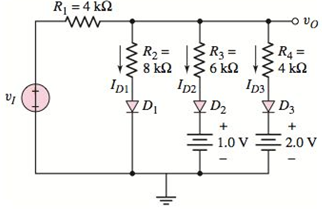
Figure P2.59
(a).
The values of
Answer to Problem 2.59P
Explanation of Solution
Given Information:
The given circuit is shown below.
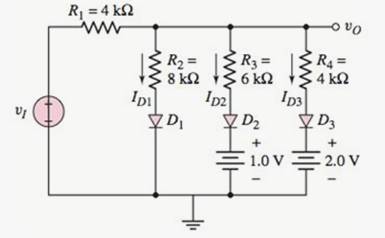
Calculation:
For
The input voltage is dropped across the output because the current in the circuit is zero.
(b).
The values of
Answer to Problem 2.59P
Explanation of Solution
Given Information:
The given circuit is shown below.
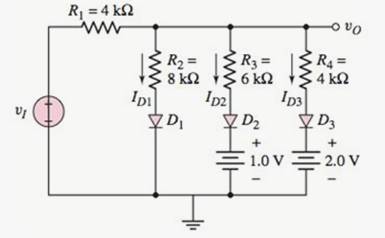
Calculation:
For
The value of diode current
The modified circuit is:
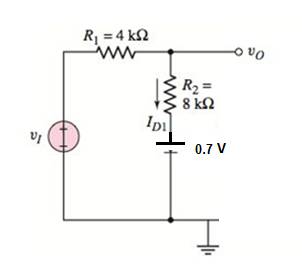
Applying Kirchhoff’s voltage law:
The value of output voltage
(c).
The values of
Answer to Problem 2.59P
Explanation of Solution
Given Information:
The given circuit is shown below.
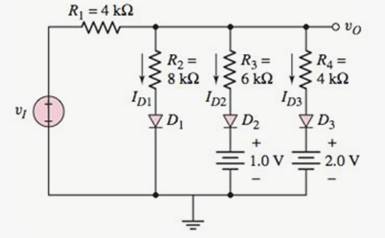
Calculation:
Assuming the diodes are in forward bias and in active mode.
Applying Kirchhoff’s current law at output node:
From above calculation diodes D1,D2 are in forward bias active mode but the diode D3 is in cut off mode because the voltage difference between positive and negative terminal is less than 0.7 V. The current through diode D3 is zero.
Hence, the assumption is incorrect.
The modified figure is:
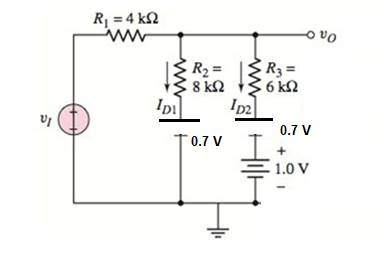
Applying Kirchhoff’s current law at output node:
The diode currents
(d).
The values of
Answer to Problem 2.59P
Explanation of Solution
Given Information:
The given circuit is shown below.

Calculation:
For
Applying Kirchhoff’s current law at output node:
The values of diode currents are:
Want to see more full solutions like this?
Chapter 2 Solutions
MICROELECT. CIRCUIT ANALYSIS&DESIGN (LL)
- Please solve it by explaining the steps. I am trying to prepare for my exam tomorrow, so any tips and tricks to solve similar problems are highly appreciated. Plus, this is a past exam I am using to prepare.arrow_forwardPlease solve it by explaining the steps. I am trying to prepare for my exam tomorrow, so any tips and tricks to solve similar problems are highly appreciated. Plus, this is a past exam I am using to prepare.arrow_forwardPlease solve it by explaining the steps. I am trying to prepare for my exam tomorrow, so any tips and tricks to solve similar problems are highly appreciated. Plus, this is a past exam I am using to prepare.arrow_forward
- Please solve it by explaining the steps. I am trying to prepare for my exam tomorrow, so any tips and tricks to solve similar problems are highly appreciated. Plus, this is a past exam I am using to prepare.arrow_forwardPlease solve it by explaining the steps. I am trying to prepare for my exam tomorrow, so any tips and tricks to solve similar problems are highly appreciated. Plus, this is a past exam I am using to prepare.arrow_forwardPlease solve it by explaining the steps. I am trying to prepare for my exam tomorrow, so any tips and tricks to solve similar problems are highly appreciated. Plus, this is a past exam I am using to prepare.arrow_forward
- It is a past exam for practice, please explain what you do so I can be prepared for exam tomorrowarrow_forwardPlease solve it by explaining the steps. I am trying to prepare for my exam tomorrow, so any tips and tricks to solve similar problems are highly appreciated. Plus, this is a past exam I am using to prepare.arrow_forwardPlease solve it by explaining the steps. I am trying to prepare for my exam tomorrow, so any tips and tricks to solve similar problems are highly appreciated. Plus, this is a past exam I am using to prepare.arrow_forward
- Please solve it by explaining the steps. I am trying to prepare for my exam tomorrow, so any tips and tricks to solve similar problems are highly appreciated. Plus, this is a past exam I am using to prepare.arrow_forwardIf C is the circle |z|=4 evaluate ff(z)dz for each of the following functions using residue. Z (a)f(z) = z²-1 Z+1 1 (b)f(z) = = (c)f(z) = z²(z+2) z(z-2)³ z² 1 1 (d) f(z) = = (e) f(z) = (f) f(z) = (z²+3z+2)² z²+z+1 z(z²+6z+4)arrow_forward5. Answer the following questions. Take help from ChatGPT to answer these questions (if you need). Write the answers briefly using your own words with no more than two sentences, and check whether ChatGPT is giving you the appropriate answers in the context of our class. a) What is the Bode plot? What kind of input do we consider for the frequency-response- based method? b) What is the advantage of design using the frequency-response method? c) Define gain margin, phase margin, gain crossover frequency, and phase crossover frequency.arrow_forward
